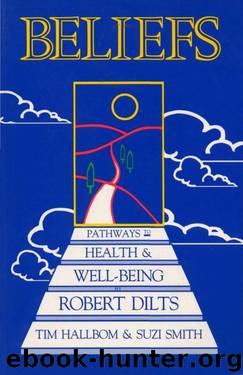Beliefs by Robert Dilts

Author:Robert Dilts [life philosophy]
Language: eng
Format: epub, mobi
Tags: life philosophy
Publisher: life philosophy
Published: 2010-11-02T07:00:00+00:00
Incongruence and Conflicting Beliefs 107
Working With Conflicting Beliefs The process that many NLP trained people would consider using to deal with two conflicting parts is the visual squash. The typical visual squash where you integrate two behaviors or collapse two anchors won't work when you have two parts that differ dramatically. It doesn't work well if you are associated into either of the two parts and you judge the other part negatively. Let me give you a typical example of this.
One of my clients went through a very hard grief process after unexpectedly losing a close relative. He started overeating and putting on a lot of weight. He had a major conflict between two aspects of his identity.
Historically, he had been a rather chubby child and hadn't felt good about himself. He had felt scared much of the time and the world seemed like an overwhelming place.
When he reached puberty, however, he grew to be rather tall and muscular and looked like Tom Selleck and thought he could do anything.
When I worked with him and we began sorting out and identifying each part, it became clear that he had one part that was full of worries, had lots of regressive thoughts, and even got paranoid about nuclear war. On the other hand, he had a part that was very confident and figured he could be successful at whatever he wanted to do. Each part was associated with a different time in his life. The "paranoid"
side was almost the complete opposite of the "confident"
side. Each was everything the other was not.
I had him dissociate from the parts by fully imagining them—how they looked, sounded, and moved—in his hands. As he described the parts, it became clear that each one was defined only in relation to the other, like matter and anti-matter, or like a communist or anti-communist (one doesn't exist without the other). When he'd identify 108 BELIEFS
with the aspect of his identity that "could do anything," he thought of the other part as both weak and useless. When he identified with the part that made him feel paranoid, he said the other part wasn't "real," it was just something he had made up. The identity of one was everything the other was not.
I realized that I couldn't just collapse two anchors or use hypnotic language to squash two pictures together to get an integration because of the beliefs involved. If I had tried and been successful, I'm positive that we would have created a disintegration of his thinking process. I had to very carefully have him sort out the parts by dissociating him from each of them as he imagined them in his hands.
As each part became more fully defined, it became clear that we needed to come up with a new belief system that included both conflicting co-identities. The way we accomplished this was to "out frame" each part's intention (using the question, "What will having that get for you?") until we found common intentions for each part. My
Download
This site does not store any files on its server. We only index and link to content provided by other sites. Please contact the content providers to delete copyright contents if any and email us, we'll remove relevant links or contents immediately.
Wonder by R.J. Palacio(7723)
The Compound Effect by Darren Hardy(7545)
Atomic Habits: Tiny Changes, Remarkable Results by James Clear(7200)
Becoming Supernatural by Dr. Joe Dispenza(7099)
Wonder by R. J. Palacio(7051)
Change Your Questions, Change Your Life by Marilee Adams(6637)
The Road Less Traveled by M. Scott Peck(6627)
Born to Run: by Christopher McDougall(6251)
Daring Greatly by Brene Brown(5636)
Grit by Angela Duckworth(4728)
Big Magic: Creative Living Beyond Fear by Elizabeth Gilbert(4718)
The Slight Edge by Jeff Olson(4716)
The Wisdom of Sundays by Oprah Winfrey(4623)
Men In Love by Nancy Friday(4315)
You Are a Badass at Making Money by Jen Sincero(4246)
Fear by Osho(4083)
The Four Tendencies by Gretchen Rubin(4018)
The Miracle Morning by Hal Elrod(3903)
Rising Strong by Brene Brown(3777)
